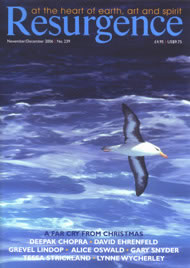THIS INSPIRED ANTHOLOGY attempts to go beneath the surface of “complex chemical, physical and biological systems interacting” to discover humankind’s incredibly diverse relationship with the Earth.
It takes as its premise that human cultures are an expression of the landscape from which they spring, and that sometimes this is not recognised by the cold stratification of scientific geology. It deals with the widely varied ways that humans understand and respond to the landscapes in which they live, in a refreshing and unusual mix of the analytical with the emotional, the geophysical with the purely metaphysical.
The book is arranged thematically in a coherent sequence; each section has an introduction to explain the forces at work and a brief description of each written piece. I have to confess to not reading these until the end – the book has such a feeling of unexpected discovery that I didn’t want to lose this by foreknowledge of the chapter contents.
Although the contents of each chapter are diverse in their origins and nature, the thematic arrangement allows them to flow into each other very naturally. There are also insightful poems interspersed throughout the book that give punctuation to the structure. Even these most spiritually, emotionally based entries seem suffused and enhanced by a deep understanding, either scientific or religious, of the Earth’s processes. The sixty-five authors included are drawn from the many cultures and ages of the last two millennia, though the focus is on the last 400 years. In this way the book documents the gradual process of humankind’s understanding and unravelling of geophysical forces without losing sight of the spiritual inheritance we have gained. This is the book’s bedrock – its broadness – from the purely scientific and observational to the inspirational and visionary. There is a huge diversity of perspectives, yet all the writers, from the eminent geophysicist to the traditional elder, share the ability to express their very strong personal experiences with immediacy, lucidity and eloquence.
Most of the dramatic developments in the evolution of life, and humans in particular, have occurred because of the constantly, eternally shifting forces at play in the Earth’s structure, and many of these writings relate the trauma and death caused by geophysical events, including Pliny the Younger’s description of the eruption of Vesuvius in 79 CE and the very moving account by Mary Austin of the 1906 San Francisco earthquake. Yet one of the entries I found most eloquent, poignant and pertinent was inflicted by humans on the landscape and thereby on their more spiritually aware fellows. This is a short piece of writing by Luther Standing Bear, an elder of the Lakota Sioux, writing in 1933 about his people’s reverence for the beauty of their winter homelands, the Black Hills of Dakota, and the white man’s greed-driven disregard for, and theft and destruction of, this beauty. To balance this out, one of the most extraordinary and exhilarating accounts is the diary record by John Wesley Powell of the first intrepid exploration by boat of the Grand Canyon, the walls of the gorge beetling over a mile high above him. He was a soldier, geologist and explorer, yet thankfully he had the ability also to write engagingly, articulately and from the heart.
Much of this book is deeply thoughtful and contemplative about the effect of landscape on the human imagination, even to the seemingly universal trait of perceiving dramatic landforms as ghostly or ruined architecture, cathedrals, castle, spires. Some of the writers take this further and use landscape as a metaphor to gain insight into the meaning of difficult areas in their lives.
Yet landscape cycles and the forces perpetually unleashed in them had an obvious, deep and profound effect on all who relate their experience in this book and express their wonder and awe. I’m grateful for their sheer ability, whoever they are or were, to write.
Tudor Humphries is a landscape painter, wildlife artist and children’s book illustrator.







